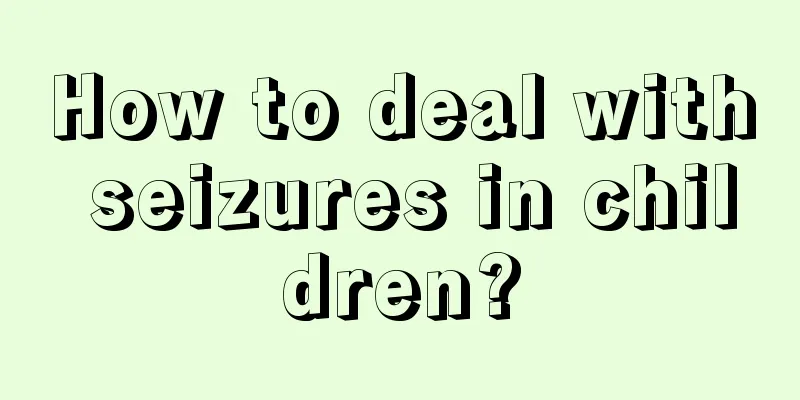What is the treatment for nasal adenoid hypertrophy in children?

|
Children are a group we care about, and they are also a group prone to diseases. In such an environment, we should take good care of our children, allow them to better prevent and treat diseases, and take them to the hospital for regular check-ups. Early detection and early treatment are very good. Pay more attention to your children's health. Children with enlarged adenoids are not only prone to respiratory infections, but also to pigeon chest, funnel chest, and even cor pulmonale. Snoring in children is more harmful than in adults. Long-term airway obstruction leads to poor lung expansion and ventilation, which can easily cause increased pulmonary artery pressure. Therefore, it is important to prevent adenoids hypertrophy and snoring at all times. There are often systemic nutritional and developmental disorders, which are mainly manifested by reflex neurological symptoms of chronic poisoning, such as dull expression, chest tightness and restlessness, poor lung expansion, which may lead to pigeon chest or flat chest over time. A few people develop cor pulmonale or even acute heart failure due to chronic nasal obstruction and long-term hypoxia. Examination revealed an adenoid face, a high and narrow hard palate, and retronasal endoscopy revealed pink, lobed lymphoid tissue masses on the roof of the nasopharynx. A soft mass could be felt on palpation of the nasopharynx. If necessary, a lateral nasopharyngeal X-ray may be performed to aid diagnosis. Children may develop otorhinolaryngology and other symptoms due to enlarged adenoids blocking the posterior nasal cavity and the pharyngeal opening of the Eustachian tube. Symptoms include open-mouth breathing during sleep, snoring with the tongue root falling back, restless sleep at night, excessive nasal secretions, occlusive nasal sounds when speaking, and slurred speech. Due to long-term mouth breathing, the facial bones are developed abnormally, the maxillary bone becomes longer, the hard palate is high and arched, the dentition is irregular, the upper incisors are exposed, the lips are thick, the face lacks expression, there are signs of dementia, and an "adenoid face" is formed. There is ataxia between swallowing and breathing, and choking and coughing often occur. The secretions flowing down irritate the respiratory mucosa, making it easy to get tracheitis. Obstruction of the Eustachian tube can easily cause non-suppurative otitis media, leading to hearing loss and retraction of the tympanic membrane. 1. Conservative treatment: pay attention to nutrition, prevent colds, improve the body's immunity, and actively treat the primary disease. As you age, the adenoids will gradually shrink and the condition may improve. 2. Drug treatment: Some children often suffer from rhinitis and sinusitis. After proper treatment, nasal ventilation will improve and clinical symptoms can be alleviated. 3. Surgical treatment: If conservative treatment is ineffective, adenoids should be removed surgically as soon as possible. The surgery is often performed together with tonsillectomy. If the tonsils are not large and rarely inflamed, adenoidectomy can be performed alone. "Transparent minimally invasive surgery" is a medical device developed based on high-end American technology. It belongs to the latest generation of physical therapy technology. Due to its outstanding clinical performance, it has completely replaced traditional treatments such as surgery, laser, and microwave in the United States and developed European countries. Medical experts unanimously believe that digital plasma treatment technology represents the highest level today. This technology is tailored for a special population with a high incidence of adenoids hypertrophy - children around 10 years old. In addition, transparent minimally invasive surgery is the latest optimized treatment plan for adenoids hypertrophy proposed by relevant authoritative departments and experts. In recent years, it has been widely used in the field of otolaryngology at home and abroad, and its clinical effects have been recognized by world authorities. The above is the treatment method for children's nasal adenoids hypertrophy. In addition to some methods of going to the hospital, you should also pay more attention to your child's diet. This is very good. In such an environment, you should take good care of your children, conduct thorough examinations, and take some preventive measures. This is a very good choice. |
<<: Why is the newborn baby so irritable?
Recommend
At what age should children start brushing their teeth?
Brushing teeth can better ensure oral hygiene and...
What should I do if my baby's eczema keeps coming back?
Eczema is a skin disease that can easily occur in...
Diet therapy to prevent hand, foot and mouth disease
We all know that hand, foot and mouth disease is ...
What symptoms will children with congenital heart disease have?
Although the current medical level is relatively ...
Six-month-old baby has fever and cold hands and feet
Since babies' immune systems are not fully de...
What can children with anemia eat to replenish blood?
Children's physical development is very fast,...
Will motor developmental delay affect intelligence?
Maybe many of our children are prone to motor dev...
How to treat baby's inguinal hernia
Inguinal hernia in babies is a common pediatric d...
What should girls pay attention to during their menstrual period?
When a girl's first menstrual period comes, s...
Why does my child keep yawning?
If a child yawns frequently, parents should pay a...
Why does my child’s back itch?
Children's skin is very sensitive and easily ...
What to do if the baby does not defecate for several days
For newborns, the digestive system determines whe...
Causes and prevention of nosebleeds in children
Nosebleeds are common in children, often when the...
Children with fever and low platelets
Children are the group most susceptible to illnes...
How to reduce fever in children with cold limbs
The phenomenon of children catching a cold cannot...









